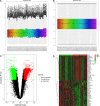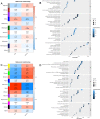Construction of the coexpression network involved in the pathogenesis of thyroid eye disease via bioinformatics analysis
- PMID: 36076300
- PMCID: PMC9461120
- DOI: 10.1186/s40246-022-00412-0
Construction of the coexpression network involved in the pathogenesis of thyroid eye disease via bioinformatics analysis
Abstract
Background: Thyroid eye disease (TED) is the most common orbital pathology that occurs in up to 50% of patients with Graves' disease. Herein, we aimed at discovering the possible hub genes and pathways involved in TED based on bioinformatical approaches.
Results: The GSE105149 and GSE58331 datasets were downloaded from the Gene Expression Omnibus (GEO) database and merged for identifying TED-associated modules by weighted gene coexpression network analysis (WGCNA) and local maximal quasi-clique merger (lmQCM) analysis. EdgeR was run to screen differentially expressed genes (DEGs). Transcription factor (TF), microRNA (miR) and drug prediction analyses were performed using ToppGene suite. Function enrichment analysis was used to investigate the biological function of genes. Protein-protein interaction (PPI) analysis was performed based on the intersection between the list of genes obtained by WGCNA, lmQCM and DEGs, and hub genes were identified using the MCODE plugin. Based on the overlap of 497 genes retrieved from the different approaches, a robust TED coexpression network was constructed and 11 genes (ATP6V1A, PTGES3, PSMD12, PSMA4, METAP2, DNAJA1, PSMA1, UBQLN1, CCT2, VBP1 and NAA50) were identified as hub genes. Key TFs regulating genes in the TED-associated coexpression network, including NFRKB, ZNF711, ZNF407 and MORC2, and miRs including hsa-miR-144, hsa-miR-3662, hsa-miR-12136 and hsa-miR-3646, were identified. Genes in the coexpression network were enriched in the biological processes including proteasomal protein catabolic process and proteasome-mediated ubiquitin-dependent protein catabolic process and the pathways of endocytosis and ubiquitin-mediated proteolysis. Drugs perturbing genes in the coexpression network were also predicted and included enzyme inhibitors, chlorodiphenyl and finasteride.
Conclusions: For the first time, TED-associated coexpression network was constructed and key genes and their functions, as well as TFs, miRs and drugs, were predicted. The results of the present work may be relevant in the treatment and diagnosis of TED and may boost molecular studies regarding TED.
Keywords: Autoimmune inflammatory disease; Differentially expressed genes; Gene coexpression networks; Protein–protein interaction; Thyroid eye disease.
© 2022. The Author(s).
Conflict of interest statement
The authors declare that they have no competing interests.
Figures







Similar articles
-
Network-Based Data Analysis Reveals Ion Channel-Related Gene Features in COVID-19: A Bioinformatic Approach.Biochem Genet. 2023 Apr;61(2):471-505. doi: 10.1007/s10528-022-10280-x. Epub 2022 Sep 14. Biochem Genet. 2023. PMID: 36104591 Free PMC article.
-
BIOINFORMATIC ANALYSIS IDENTIFIES POTENTIALLY KEY DIFFERENTIALLY EXPRESSED GENES AND PATHWAYS IN ORBITAL ADIPOSE TISSUES OF PATIENTS WITH THYROID EYE DISEASE.Acta Endocrinol (Buchar). 2019 Jan-Mar;-5(1):1-8. doi: 10.4183/aeb.2019.1. Acta Endocrinol (Buchar). 2019. PMID: 31149053 Free PMC article.
-
Novel insights into the pathogenesis of thyroid eye disease through ferroptosis-related gene signature and immune infiltration analysis.Aging (Albany NY). 2024 Mar 25;16(7):6008-6034. doi: 10.18632/aging.205685. Epub 2024 Mar 25. Aging (Albany NY). 2024. PMID: 38536014 Free PMC article.
-
Exploration of key drug target proteins highlighting their related regulatory molecules, functional pathways and drug candidates associated with delirium: evidence from meta-data analyses.BMC Geriatr. 2023 Nov 22;23(1):767. doi: 10.1186/s12877-023-04457-1. BMC Geriatr. 2023. PMID: 37993790 Free PMC article.
-
Beyond modules and hubs: the potential of gene coexpression networks for investigating molecular mechanisms of complex brain disorders.Genes Brain Behav. 2014 Jan;13(1):13-24. doi: 10.1111/gbb.12106. Epub 2013 Dec 10. Genes Brain Behav. 2014. PMID: 24320616 Free PMC article. Review.
Cited by
-
Identification of key extracellular proteins as the potential biomarkers in thyroid eye disease.PLoS One. 2025 Apr 29;20(4):e0322415. doi: 10.1371/journal.pone.0322415. eCollection 2025. PLoS One. 2025. PMID: 40299971 Free PMC article.
-
Formerly degenerate seventh zinc finger domain from transcription factor ZNF711 rehabilitated by experimental NMR structure.bioRxiv [Preprint]. 2024 Apr 10:2024.04.06.588434. doi: 10.1101/2024.04.06.588434. bioRxiv. 2024. Update in: Protein Sci. 2024 Sep;33(9):e5149. doi: 10.1002/pro.5149. PMID: 38645208 Free PMC article. Updated. Preprint.
-
The shared mechanism and potential diagnostic markers for premature ovarian failure and dry eye disease.Sci Rep. 2024 Jul 13;14(1):16178. doi: 10.1038/s41598-024-67284-3. Sci Rep. 2024. PMID: 39003404 Free PMC article.
-
Development and validation of potential molecular subtypes and signatures of ocular sarcoidosis based on autophagy-related gene analysis.Open Med (Wars). 2025 Aug 5;20(1):20251243. doi: 10.1515/med-2025-1243. eCollection 2025. Open Med (Wars). 2025. PMID: 40771354 Free PMC article.
-
Integrated machine learning and Mendelian randomization reveal PALMD as a prognostic biomarker for nonspecific orbital inflammation.Sci Rep. 2024 Oct 14;14(1):24020. doi: 10.1038/s41598-024-74409-1. Sci Rep. 2024. PMID: 39402101 Free PMC article.
References
Publication types
MeSH terms
Substances
LinkOut - more resources
Full Text Sources
Research Materials
Miscellaneous

